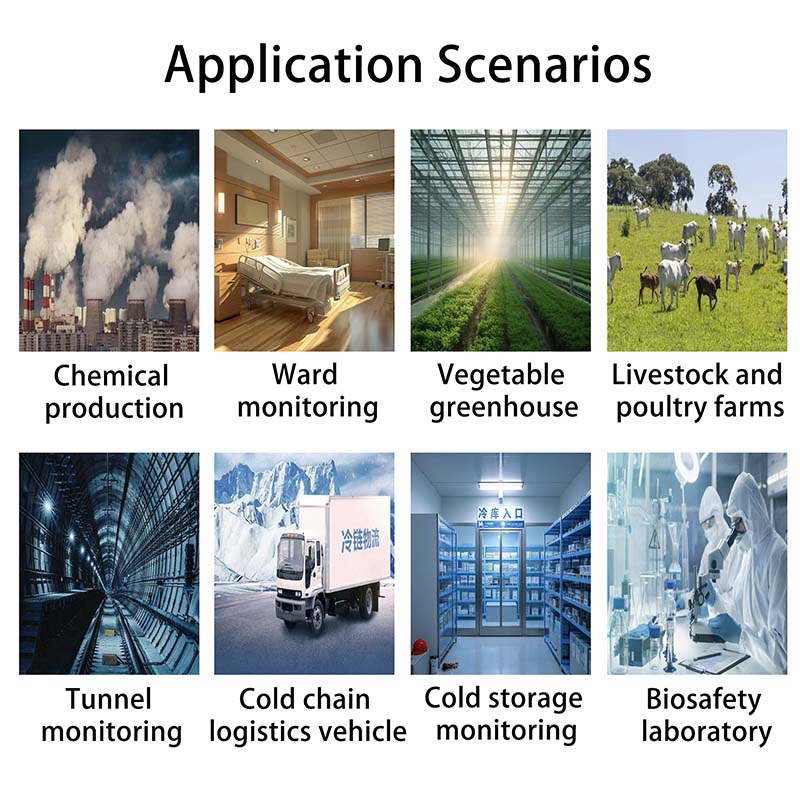Ozone (O3), as the "protective umbrella" of the stratosphere, is a harmful air pollutant in the troposphere, posing a significant threat to respiratory health, crop growth, and even material lifespan. Accurate, efficient, and large-scale monitoring of ozone concentration is key to improving air quality, safeguarding public health, and ensuring production safety. In this context, LoRaWAN gas ozone sensors are becoming the backbone of environmental perception networks with their unique advantages.
Core Architecture: Perfect Integration of Perception and Connection
1、Ozone ( O3 ) sensing unit:
2、LoRaWAN communication module:
Disruptive Advantage: Why Choose LoRaWAN?
Core values and application scenarios
1. Grid based monitoring of urban and community air quality:
High density deployment around streets, parks, schools, and transportation hubs, real-time mapping of fine ozone pollution.
Identify pollution hotspots, track pollution diffusion pathways, and provide data support for precise governance decisions (such as traffic control and industrial emission adjustments).
Provide real-time air quality information to the public and enhance environmental health awareness.
2. Industrial safety and compliance monitoring:
Continuous monitoring of workplace ozone concentration in areas with risks of ozone generation or leakage, such as chemical plants, printing plants, water treatment facilities, and semiconductor workshops.
Ensure the occupational health of workers, promptly report to the authorities when the concentration exceeds the standard, and coordinate with the ventilation system.
Automated recording of emission data to meet environmental regulations (such as EPA, EU-ETS, etc.) and simplify compliance reporting processes.
3. Smart Agriculture and Forestry Protection:
Monitor the ozone concentration in farmland, orchards, and greenhouses to assess their stress effects on crops, especially sensitive crops such as grapes, tobacco, and soybeans.
To provide a basis for optimizing planting management, selecting resistant varieties, and evaluating yield losses.
Monitor ozone levels in forest areas and study their impact on ecosystems.
4. Indoor Air Quality (IAQ) Management:
Deploy in offices, schools, hospitals, museums, and other places to monitor indoor ozone generated by equipment such as copiers, laser printers, and air purifiers.
Ensure the health and comfort of indoor personnel, and coordinate with the fresh air system for adjustment.


Key considerations
1.Accuracy and Calibration: Sensor accuracy (such as ± 10 ppb or ± 10% reading) must meet application requirements. Regular calibration (on-site or laboratory) is crucial, and some high-end sensors support automatic baseline calibration.
2.Environmental compensation: Ozone measurement is easily affected by temperature and humidity, and the sensor needs to have a good temperature and humidity compensation algorithm.
3.Cross interference: Clarify the cross sensitivity of sensors to other gases (such as NO2, VOCs), and if necessary, choose models with strong anti-interference ability or perform data calibration.
4.Protection level: Choose the appropriate IP protection level (such as IP65/IP67) based on the deployment environment (outdoor, industrial area).
5.Balancing data frequency and power consumption: Reasonably set the sampling and reporting frequency based on monitoring objectives (real-time warning vs. trend analysis) to optimize battery life.
6.LoRaWAN network coverage: Before deployment, it is necessary to confirm the network coverage of the target area (public networks such as The Things Network or private networks).
LoRaWAN O3 sensor vs. other technologies
| characteristic | LoRaWAN O3 Sensor | NB-IoT/Cat-M1 O3 Sensor | WiFi/Honeycomb (4G/5G) O3 Sensor |
| Coverage | Ultra long distance (kilometer level) | Long distance (better than cellular) | Dependent on base station density |
| power consumption | Extremely low (battery years) | Low | High (frequent charging and battery swapping) |
| Deployment cost | Low (wide gateway coverage) | Centre | Medium to high (dependent on operator) |
| penetrability | Strong | Strong | Centre |
| Applicable scenarios | Wide area, decentralized, no power supply, low speed | Wide area, requiring higher bandwidth, mobility | Fixed, powered, requiring high bandwidth/real-time |
| Monthly fee | Usually none/very low (private network) or low (public network) | Yes (operator data fee) | Yes (higher data usage fees) |
Future prospects
LoRaWAN O3 sensors will continue to evolve: sensors with higher accuracy/lower power consumption, more intelligent edge computing (local pre-processing, anomaly detection), stronger environmental robustness, and predictive pollution analysis combined with AI. They will work together with LoRaWAN sensor nodes that monitor PM2.5, NO2, SO2, VOCs, etc., to jointly build a high-density, low-cost, real-time smart environment Internet of Things, providing a powerful data foundation for safeguarding blue skies and white clouds, and ensuring health and safety.
summarize
LoRaWAN gas sensors,O3 sensor with their revolutionary long-range, low-power, and easy to deploy features, are fundamentally changing the mode of ozone monitoring. It breaks through the constraints of traditional wired or high-power wireless solutions, making it economically feasible to deploy dense and sustainable monitoring networks in vast areas. Whether it's the blue sky defense battle of smart cities, the safety net of factories, or the precise management of farmland, this silent guardian is silently providing key environmental intelligence, driving smarter and healthier decisions, and contributing to building a more sustainable future.